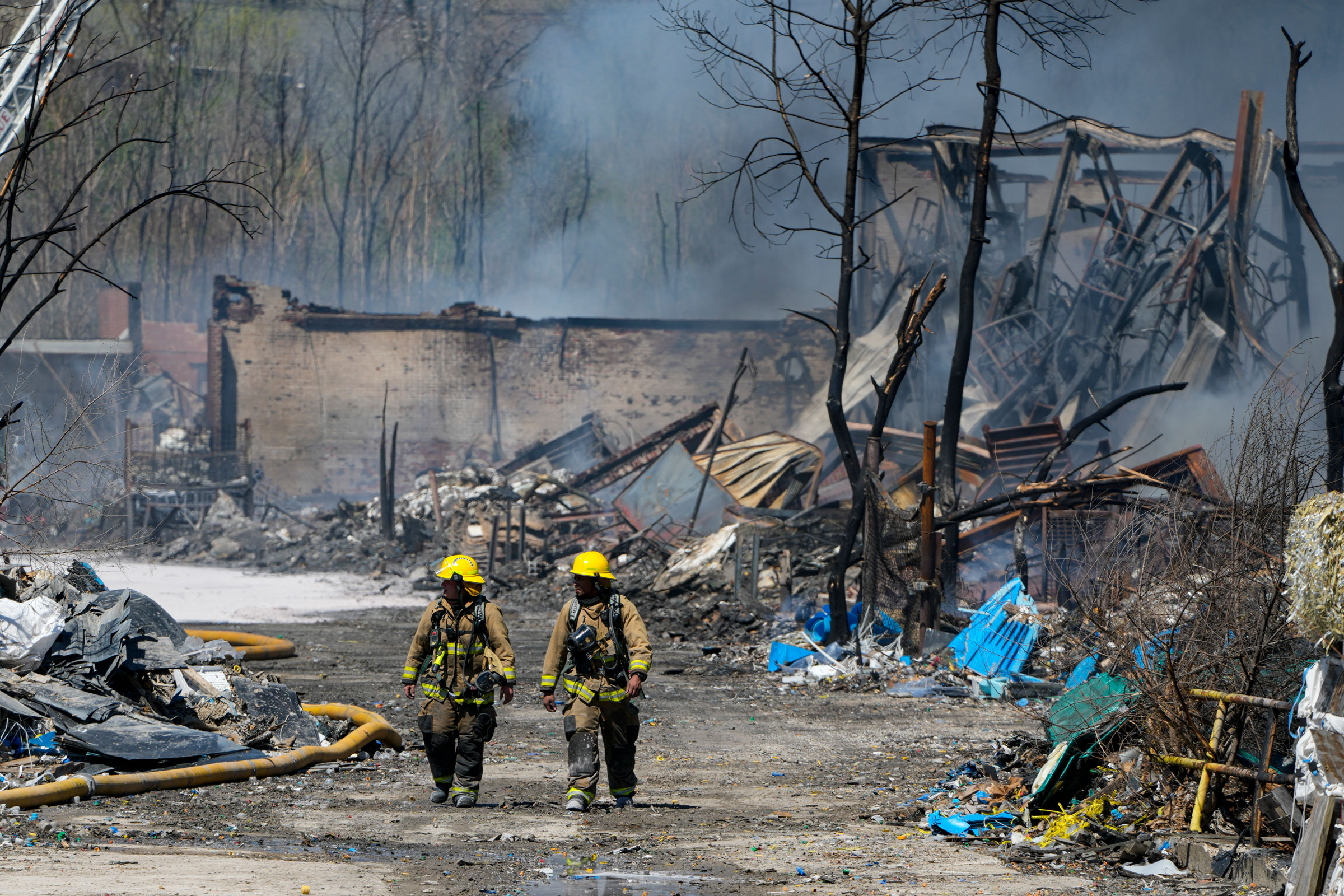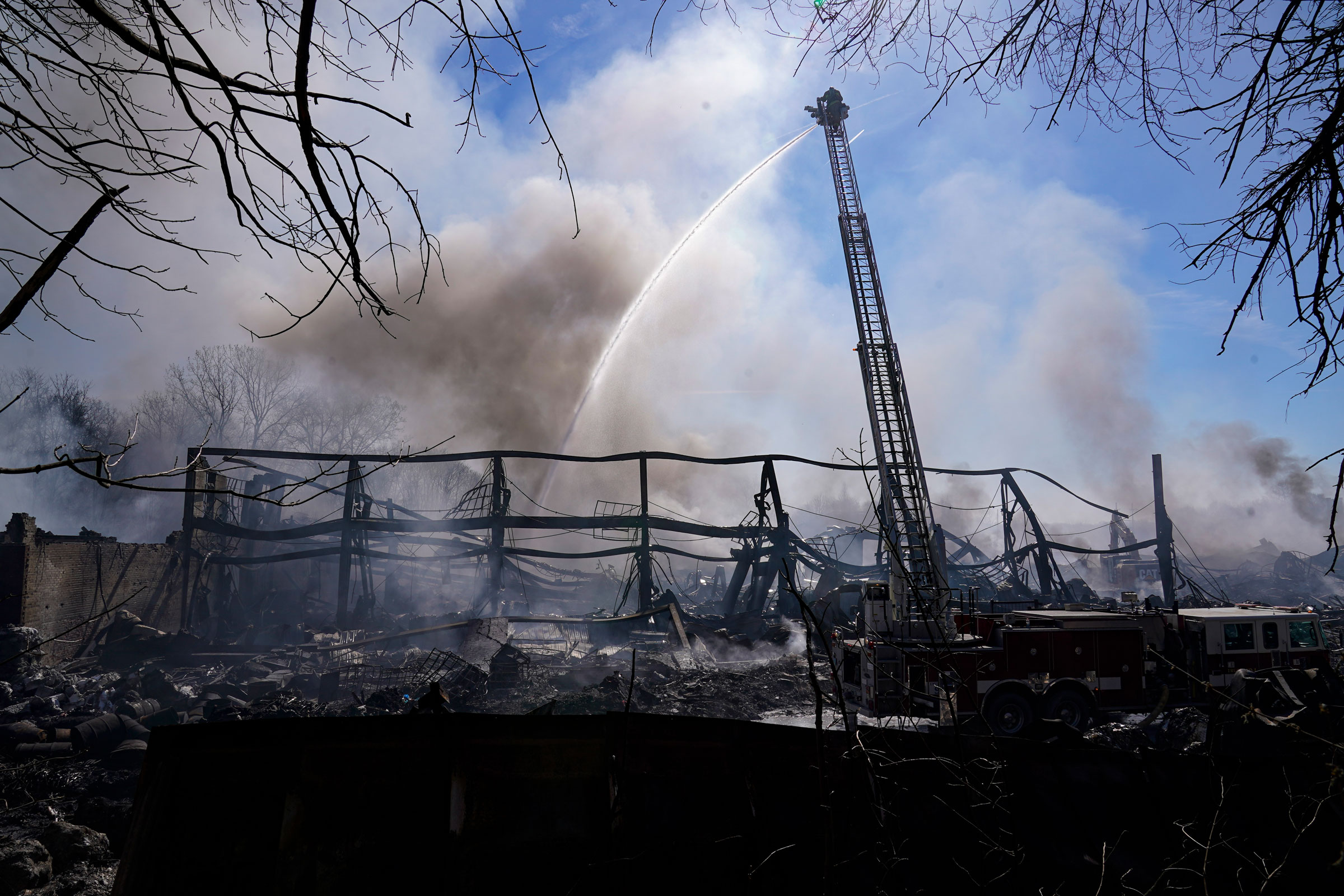A huge plume of smoke, visible from miles around, continues to billow over a plastics recycling plant in the city of Richmond, Indiana, where a fire broke out Tuesday afternoon. Some 2,000 people living within half a mile of the facility were forced to evacuate to escape harmful fine particulate matter and potentially toxic chemicals in the air, and building debris falling on their lawns. Once lit, plastic fires are incredibly tough to put out, and officials say the plant will burn for several more days.
As recycling plant fires go, the Richmond blaze is particularly dramatic. But it’s far from an isolated incident: at least two similar fires broke out the same day, one at a paper recycler in Jersey City, NJ, and another at an auto recycler in Calgary, Canada. Last week, a fire destroyed a recycling center in Hernando County, Florida. The week before, it was a plant in Fort Myers. The list goes on and on.
Recycling fires are increasingly common in North America. The number of major fires reported at plants in the U.S. and Canada has increased by more than a third since 2017, hitting 390 in 2022. By the end of March this year, 75 more had taken place. Those figures come from Ryan Fogelman, an entrepreneur who works with fire prevention company Fire Rover and began tracking media coverage of recycling fires in 2016 in the absence of official data. With smaller fires going unreported, he estimates that the real number is closer to 2,400. The blazes killed three people and injured 63 last year. They also release toxic fumes, increase the risk of wildfires, and cause millions of dollars in damage for a sector under pressure to scale up as part of cities’ green goals.
Experts say the recycling industry is facing a cocktail of factors that increase the risk of fires, from a growing number of new plants opening to deal with growing demand, to major new hazards in the products people recycle, to global shifts in the management of waste. On top of that, a hotter, drier climate is making it easier for fires to spread inside plants, with blazes starting earlier each year.
How risks have grown in recycling plants
Recycling has always involved some fire risk. In the U.S., the practice of repurposing waste, rather than burying it, began to take off in the late 20th century, with the volume of recycled waste growing twelvefold from 1960 to 2018, per the EPA. Ever since then, plant operators—a mix of government agencies and private contractors—have had to deal with a wide range of flammable substances, like aerosols, paint, fuel canisters, and ashes. While those things are meant to go to special facilities, waste management experts say they are often dumped in with paper and plastic recycling by the public. They also arrive hidden in debris from construction sites and damaged cars sent by industrial recycling customers.
But over the last five years, an explosion in the number of products containing rechargeable lithium ion batteries, such as vapes, airpods, cell phones, and smart watches, has turbocharged the problem. When damaged in the transport or crushing of waste, these batteries can begin to release the energy they contain and self-ignite, potentially setting fire to the materials around them. A 2018 survey by the California Product Stewardship Council found that 40% of fires at the state’s waste management facilities are triggered by lithium ion batteries.

The challenge is not just the growing number of batteries being thrown away. (Safe recycling campaign group Call2Recycle estimates that 58 million pounds of lithium ion batteries reached the end of their usable life in 2020.) It’s also the increased difficulty of filtering out these tiny combustibles. “In the old days, you would have these traditional hazards like a propane tank that a human being could spot and pull out before it got into your shredders,” Fogelman says. “Now, even some greeting cards [contain batteries]. Even a sophisticated robotic arm is going to identify that as a piece of paper, it doesn’t know it’s metal.”
There are other aggravating factors beyond the batteries. Plant managers say they are struggling to shift large stockpiles of plastic waste. The main market for recycling U.S. plastic used to be China. But in 2018, after public backlash over the impact of millions of bales of contaminated waste on Chinese communities and the environment, the government enacted a ban on plastic waste imports. While many large U.S. cities have managed to find domestic markets for plastic, small towns have struggled, leading to a build-up of plastic products at plants. And because plastic is made from oil and natural gas, the build-up provides plenty of long-burning fuel for battery fires. (It seems the initial fallout from China’s policy change may have contributed to a spike in fires in 2018, while it appears reduced recycling activity during COVID lockdowns may have limited the numbers in 2020.)
Though officials have yet to determine the cause of Richmond’s blaze, plastic build up may have played a role. The city’s fire chief said Tuesday that the facility was “completely full from floor to ceiling and from wall to wall.”
Faltering efforts to curb fires
The number of fires has continued to grow in the first three months of 2023 compared to last year, per Fogelman’s figures. That’s despite efforts to get a grip on the problem. Municipalities, national governments, and national recycling organizations are pushing public education campaigns to stop people sending dangerous substances into the recycling system. The EPA has advice on how to safely recycle products containing lithium ion batteries.
Some states, including California, have introduced so-called “extended producer responsibility” schemes, obliging the manufacturers of electrical goods to set up systems to recycle lithium batteries. Health-related bans on disposable vapes in many countries, including Mexico and China, should also reduce the pressure on recyclers.
The blame for the Richmond fire, however, may lie with the plant owners. Local officials say they had already flagged a series of building code violations at the plant, and an unsafe stockpile of plastic. In 2020, a court ruled that the facility was a fire hazard, but according to CNN it’s unclear what steps the city or the owners took to remedy those problems.

Fogelman argues that, in general, plant operators need more support to deal with the shifts in the economy that have transformed their industries. Extended responsibility schemes like California’s should require product manufacturers to help plants roll out fire detection systems, One solution is marketed by Fire Rover, which uses thermal sensors to detect fires and human camera operators to decide when targeted sprinkler systems need to be used. Other fire monitoring technologies are available from competitors.
“The plant operators, along with the firefighters, are the victims in all this,” Fogelman says. “They’re the ones who are dealing with the shit rolling downhill.”
More Must-Reads from TIME
- Why Biden Dropped Out
- Ukraine’s Plan to Survive Trump
- The Rise of a New Kind of Parenting Guru
- The Chaos and Commotion of the RNC in Photos
- Why We All Have a Stake in Twisters’ Success
- 8 Eating Habits That Actually Improve Your Sleep
- Welcome to the Noah Lyles Olympics
- Get Our Paris Olympics Newsletter in Your Inbox
Write to Ciara Nugent at ciara.nugent@time.com
